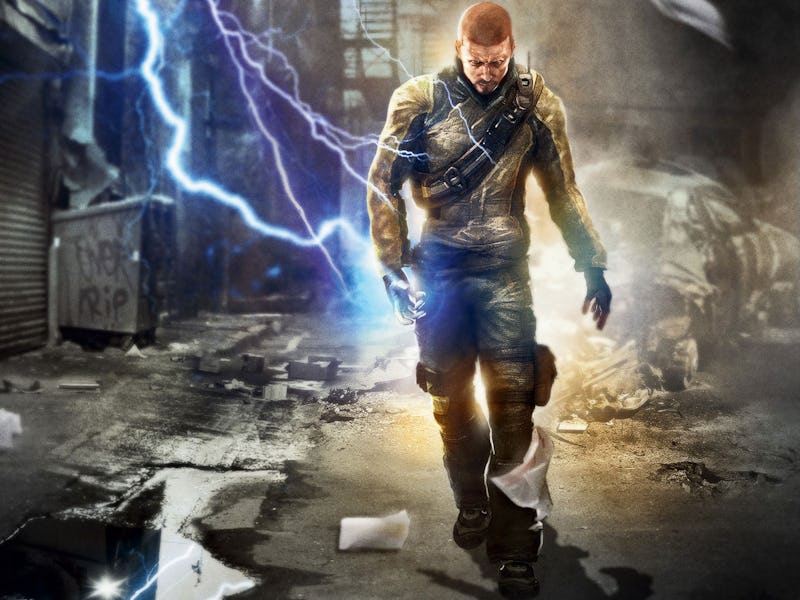15 Years Ago, PlayStation's Forgotten Superhero Made His Electrifying Debut
Shock and awe.

Long before Marvel’s web-slinger leaped onto PlayStation platforms in 2018, developer Sucker Punch Productions created a wholly original superhero franchise exclusively for PlayStation. And while it seems like a distant memory overshadowed by Insomniac’s universally beloved Spider-Man games some 15 years later, Infamous was a compelling start to a new kind of superhero franchise, one that was both far ahead of its time and emblematic of everything trope games needed to subvert.
When Infamous was released, it had been a little over two years since the PlayStation 3 stumbled onto the market. It was trailing behind the competition in terms of both sales and public perception thanks to hard-to-use development tools, shoddy ports of popular games like The Orange Box and Fallout 3, and being the most expensive new console available.
But as it goes in the games business, being down and out can cultivate fallow ground for innovation. With their against the wall, Sony doubled down on publishing the most interesting set of first-party exclusives that generation, a strategy that worked wonders for them in the long run and has continued well into the PlayStation 5 era.
Infamous was one of several big swings from PlayStation’s first-party studios during the PlayStation 3 era.
Sucker Punch, known best for the beloved Sly Cooper series on PlayStation 2, decided they’d try their hand at creating something entirely new in the then-fresh open-world superhero genre. Both Spider-Man 2 (based on the 2004 Sam Raimi film) and The Incredible Hulk: Ultimate Destruction had figured out the formula of mashing together the theatrics of comic book heroism and the freedom of open-world design. But there was still a lot of untapped potential in this new concept, and Sucker Punch wanted to be the first to realize it.
Infamous follows a man named Cole MacGrath, a bike messenger caught in the middle of a mysterious explosion that decimates several city blocks in the heart of Empire City. Amidst the tragedy, Cole gains a variety of electricity-based powers. Throughout the game, Cole learns to hone his powers, with the player ultimately deciding to use them for good or evil. Infamous is steeped in 2000s era “cool.” The hilariously named protagonist being a gruff, short-haired white dude (as was the style of the time) will give modern players plenty to roll their eyes at some 15 years later. Despite its Teen rating, the game leaned into a darker tone more aligned with popular graphic novels and independent comes instead of the more colorful fare of heroes like Superman.
Regardless of how poorly some of the game’s choices have aged, this was still one of the industry’s most prolific and creative studios at the helm. Infamous incorporated a comic book-style presentation, using panels and hand-drawn art for cutscenes.
Infamous used comic book-style art for its cutscenes.
Infamous’ story was fairly straightforward: hero man finds his calling and uncovers the truth of what happens. But this game was released before the Marvel Cinematic Universe had truly taken hold, and before both Marvel and DC gladly handed over IP to the industry’s most talented developers. The novelty of the superhero origin story hadn’t yet become the tired character arc it is today, and Cole’s adventure was a hero’s journey worthy of seeing to its end.
Speaking of character arc, Infamous’ morality system was another major feature. Depending on your choices, Empire City pedestrians perceived Cole as either a savior or a terrifying villain. The choices would also impact how Cole looked and what powers he had access to.
Unfortunately, even by 2009 standards, there’s little nuance in Infamous’ definition of player choice. An early mission tasks players letting starving citizens eat provisions or shooting at them with electric powers. It makes most of the evil choices seem so nihilistic, they become kind of funny.
As much as there is to pick apart in the first Infamous, there’s one fact that trumps all the negatives — it’s a total blast to play. Cole’s starting powers are objectively cool, and they only get better as the game progresses. Throwing electric punches, shooting enemies at further distances, and hovering to traverse the city all feel great and create a convincing power fantasy. The draining sources of electricity to keep your electric reserve full for powers was a neat mechanic that kept traversal and combat encounters interesting. And as basic as the world-building is, Infamous was a wholly unique IP that set up lots of intrigue for future entries.
The last entry in Sucker Punch’s superhero series was 2014’s Infamous: Second Son.
Thankfully, Sucker Punch got to make good on that potential. 2011’s Infamous 2 doubled down on the comic book inspiration and thankfully lightened things up literally and figuratively. It traded the gray and gloomy streets of Empire City for the New Orleans-inspired New Marais, and made Cole less of a brooding anti-hero. 2014’s Infamous Second Son and its expansion First Light continued the trend on the PS4, marking the last entry in the series.
There hasn’t been any rumbling of a new Infamous since the 2014 game. Sucker Punch would go on to make 2020’s Ghost Of Tsushima, and is rumored to be working on a sequel. And with the success of Spider-Man 2, it doesn’t seem likely that players will see the return to PlayStation’s lesser-known superhero franchise.
But I’d argue that maybe Sony and Sucker Punch reconsider. Infamous was a consistently fun series, one that feels like an appropriately pulpy send-up of the superhero genre. With it being an original IP, Sucker Punch could take interesting risks Sony never could with Marvel’s iconic cast of characters. The original Infamous may feel a bit dated 15 years later, but it still has much of the old-school charm missing from the current landscape of superhero games.